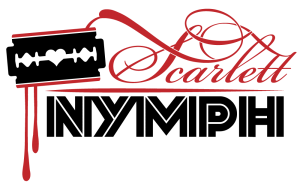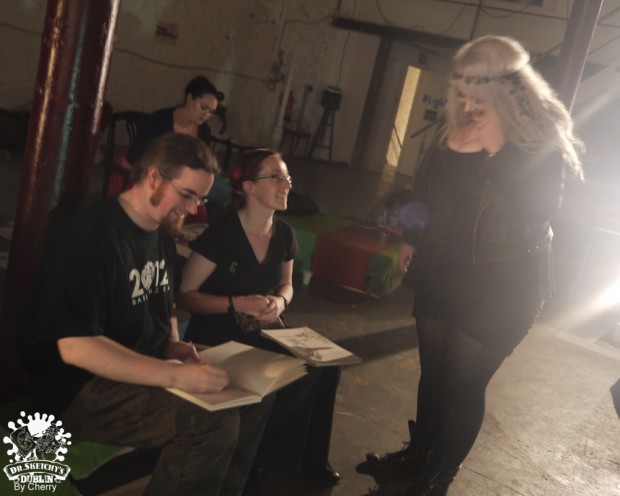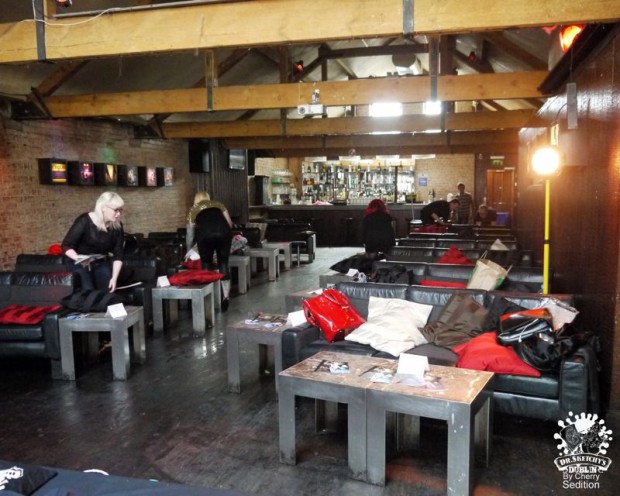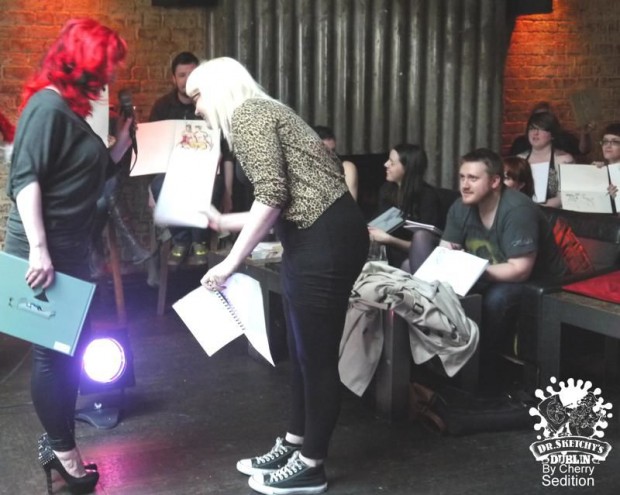Make-Up Artist, glamorous assistant at Dr Sketchy’s Dublin and all round babe Lucy James (pictured) recently asked if she could interview me about Dr Sketchy from a business perspective for a college assignment. I really enjoyed answering her questions and thought it might make for an interesting read on my blog!
Lucy James: What is Dr Sketchys?
Scarlett Nymph: Dr Sketchy’s Anti Art School is a worldwide art movement combining life drawing, cabaret, performance and music. There are over 150 branches worldwide hosting monthly events.
The movement originated in New York, started by prolific illustrator and artist Molly Crabapple. The organisation is set up as a franchise, each branch has responsibilities to stay true to the original branch and must pay monthly ‘dues’.
While we have roles and responsibilities to the brand, we also have the freedom to adapt our individual branches to our own communities, to the resources available, to our audience and to push it to the limits of our own creativity.
At Dr Sketchy’s Dublin branch, our sessions have a unique theme every month – movie themes, literary themes, art movements – and we feature two beautiful models, stunning performers, boozy prices and a DJ playing throughout.
The aim of Dr Sketchy’s Anti Art School is to take art and creativity out of the classroom and sterile environments, to make sketching fun and sociable.
LJ: What ignited the spark in you to start this new venture? How did the idea for Dr Sketchy’s come about?
SN: In 2010, myself and my partner Brian started producing alternative events as a hobby. We had both been aware of the Dr Sketchy movement for a long time and were fans of the concept. There had been a branch operating in Dublin already, but when we found out that had ended and cleared it with the original branch headmistress, we decide to approach HQ and enter the application process to take over the branch.
LJ: How do you find people to bring into your organization that truly care about the organization the way you do?
SN: Being an organisation focused in the creative industry naturally attracts like-minded people. Our branch has grown organically, supported by both our core crew and a wonderfully encouraging audience. Having the support of a world wide network of other branches is invaluable to overcoming difficulties or accessing a huge knowledge base of experience.
We have also been involved in some incredible collaborations with great, like-minded people who have not only been advocates for what we do, but have pushed us to evolve and develop.
LJ: How important have good helpers and members been to your success?
SN: It’s the most important key to our success. Without the support of our crew, running our organization would be next to impossible. From the moment we announce each individual event, my crew helps me to manage our social networks, myself or a more talented graphic designer provides the artwork for the posters, models source or make costumes to fit the theme – often more than one outfit, we source or make props and dress the stage, performers often create new numbers tailored to the theme, myself or another DJ will source music for a customised playlist – and that’s all before the day of the event, not to mention marketing, ticket sales administration etc. After each session our photographer processes 100s of images and selects which ones to edit and send to me to share on our pages. Our sessions are monthly but the work is ongoing.
LJ: What have been some of your failures, and what have you learned from them?
SN: In the past, I have sometimes made myself and Dr Sketchy’s Dublin too readily available for projects and collaborations without reviewing the impact of the projects on our core events, or allowed ourselves and our crew to become overextended due to taking on the wrong projects, or the right projects but at the wrong time.
I am learning to review opportunities more critically and be selective. Also to acknowledge that’s not selfish, it’s business sense.
Another failure has been to become to relaxed when things are going well. It can be easy to take your foot off the accelerator and become lax when you’re filling venues or turning people away, but just as quickly those numbers can drop, so you must stay on your toes.
LJ: How do you come up with new and creative theme ideas?
SN: Inspiration is everywhere, it’s almost more difficult to narrow down the ideas and be selective than it is to come up with new ideas. Come back to me in 5 years and hopefully the answer will be the same!
LJ: How long do you stick with an idea before giving up?
SN: I think you can tell pretty quickly whether something is going to work or not. If something has ‘failed’, sit back, take stock and review. What went wrong, why did it go wrong, what can be learned, what can be improved upon. If the answer to the last two questions is “nothing”, then you move on and create something else.
I want to be the best possible me. I want to use all my skills and abilities and share my creativity.
LJ: What motivates you??
SN: I want to be the best possible me. I want to use all my skills and abilities and share my creativity. Every month, my favourite time is right after a Dr Sketchy’s Session, eating and drinking with my crew, knowing we did our best and created something special.
LJ: How do you define success?
SN: Success is feeling satisfied that you have done your best and stood out from the crowd.
It’s taking a risk, stepping out onto a ledge and being rewarded by having people use your service or buy your product.
LJ: Is your company profitable or what is your profit for last year?
SN: We are still in the early days of our branch becoming a viable business. We are not yet profitable but are holding our own.
LJ: Where did your organization’s funding/capital come from and how did you go about getting it?
SN: Out of my own pocket.
LJ: How do you build a successful customer base?
SN: We have grown through word of mouth, the support of the worldwide brand and working hard on social media. I believe the key is consistency, if people come and enjoy themselves, when they return they want to have the same experience.
LJ: To what do you most attribute your success?
SN: Taking risks, taking leaps of faith, trying not to allow what we do to become stale, constantly looking for the next idea or project and last but definitely by no means least, surrounding ourselves with the right people.
LJ: What would say are the five key elements for starting and running a successful business?
SN: Consistency – delivering a clear message about what the brand is, delivering a quality service every single time.
Communication – ensuring you are always communicating with your audience, both sending out information and listening to feedback and critique.
Taking strategic risks – constantly reviewing what works and what doesn’t work, don’t be afraid to ditch what isn’t successful.
People – Having the right people around you as your advocates and supporters. Apart from helping with the workload, they believe in your brand. Ensure they always feel valued and appreciated.
Budgeting – Never invest more money than you can afford to lose.
LJ: What has been your most satisfying moment in business?
SN: Being interviewed on camera by Alan Cumming for a Sky Atlantic television series ‘Urban Secrets’.
LJ: How do you go about marketing your business? What has been your most successful form of marketing?
SN: The majority of our marketing is online through social media. It can be easy to stick to that because it’s less expensive than printing and distributing flyers and posters. We need to work on a comprehensive marketing strategy for 2013.
LJ: What sacrifices have you had to make to be a successful entrepreneur?
SN: The biggest sacrifice is the security of having a regular wage paid into your bank account.
LJ: What do you feel is the major difference between entrepreneurs and those who work for someone else?
SN: I will always work my ass off. I wasn’t made for a life of leisure, however, if I’m going to work long hours or overtime, I want to be making money to go into my bank account, not someone else’s. Being an entrepreneur is difficult, but rewarding.
All Photos by Kerri Cherry




